 |
In times of trouble we turn to religion. Indeed,  following the recent terrorist attacks American houses of worship reported a huge surge in attendance. following the recent terrorist attacks American houses of worship reported a huge surge in attendance.
For musical inspiration, nearly all the major classical composers included religious works among their significant output and left us a large body of masterpieces from which to chose.  Each reflected the fundamental artistic personality of its creator. Thus, Bach's cantatas are devout reflections of the unity and ubiquity of the God who constantly guided his thoughts, Haydn's masses are animated by the same lusty life-affirming vigor as his symphonies and quartets, Beethoven's Missa Solemnis is firm and imposing, Schubert's masses are lyrical and songful, Verdi's Requiem is stormy and operatic, Janacek's Slavonic Mass is fiercely nationalistic and Stravinsky's Mass is lean and ascetic. (Of course, as with every rule there are exceptions – Dvorak's music typically bounds with rural vitality, but his lovely Stabat Mater is meditative and pastoral throughout.) Each reflected the fundamental artistic personality of its creator. Thus, Bach's cantatas are devout reflections of the unity and ubiquity of the God who constantly guided his thoughts, Haydn's masses are animated by the same lusty life-affirming vigor as his symphonies and quartets, Beethoven's Missa Solemnis is firm and imposing, Schubert's masses are lyrical and songful, Verdi's Requiem is stormy and operatic, Janacek's Slavonic Mass is fiercely nationalistic and Stravinsky's Mass is lean and ascetic. (Of course, as with every rule there are exceptions – Dvorak's music typically bounds with rural vitality, but his lovely Stabat Mater is meditative and pastoral throughout.)
While religious sentiment infuses the work of many 20th Century composers, few major productions have emerged. Of those, most disdain traditional approaches and ritual for modern cynicism, questioning and testing time-honored assumptions. Thus, Britten's deeply unsettling 1962 War Requiem juxtaposes Latin hymns of faith with the bitter anti-war verses of Wilfred Owen, a poet killed in service near the close of World War I. Similarly, Bernstein's 1963 Kaddish Symphony and 1971 Mass challenge their respective Jewish and Catholic liturgies through characters who argue with God and ultimately emerge from the process badly shaken with only a tenuous faith.
All the more amazing, then, that late in his life Francis Poulenc 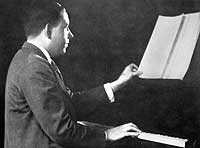 (1899 – 1963) wrote a gorgeous soul-affirming work that combines modern brevity and freshness with traditional creed and technique to bestow a wondrous resource for our troubled times. As with the heartfelt religious masterworks of his illustrious predecessors, Gloria served to summarize all Poulenc had experienced and become. While it goes without saying that all composers reflect a range of influences, Poulenc's were far more sweeping than most. (1899 – 1963) wrote a gorgeous soul-affirming work that combines modern brevity and freshness with traditional creed and technique to bestow a wondrous resource for our troubled times. As with the heartfelt religious masterworks of his illustrious predecessors, Gloria served to summarize all Poulenc had experienced and become. While it goes without saying that all composers reflect a range of influences, Poulenc's were far more sweeping than most.
Poulenc was largely self-taught and thus apt to absorb a wider range of musical sources than those normally imposed by strict classical training. That, in turn, led him to become an incessant borrower, not out of laziness but out of genuine respect for music he loved and not as a crutch until he found his own footing but throughout his maturity as well – indeed, his final two sonatas for clarinet and oboe consciously evoke the distinctive qualities of Prokofiev and Honegger. Nearly all his work is a deft mixture of styles, suffused with ideas from Gregorian chant to burlesque.
Poulenc then studied with Ricardo Viñes, a pioneering pianist who championed the then-new work of Debussy, Ravel and others on the cutting edge of modernism.  Poulenc not only developed into a fine pianist himself, but absorbed that special feeling of delicate sensuality intrinsic to French music. His earliest works, like the 1918 Mouvements perpetuels, fully reflect this feeling, bursting with effortless melody and diffident grace. Despite Viñes' influence, though, Poulenc had no interest in sounding modern, even going so far as to write outmoded concertos for harpsichord and organ. His music generally has far more to do with preceding centuries than his own. Poulenc not only developed into a fine pianist himself, but absorbed that special feeling of delicate sensuality intrinsic to French music. His earliest works, like the 1918 Mouvements perpetuels, fully reflect this feeling, bursting with effortless melody and diffident grace. Despite Viñes' influence, though, Poulenc had no interest in sounding modern, even going so far as to write outmoded concertos for harpsichord and organ. His music generally has far more to do with preceding centuries than his own.
Poulenc's first fame (or perhaps notoriety) came with Les Six, a group of six rebellious young French composers inspired by Erik Satie,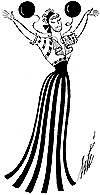 who specialized in brief piano pieces whose sweet and wistful lyricism belied such bizarre titles as “Things Seen From Right to Left Without Glasses,” “Limp Preludes for a Dog” and “Bureaucratic Sonata.” Les Six rejected wispy French impressionism along with both of the alternative trends of their time – the sobriety of composers who clung to the serious and comfortable forms of the past as well as modernists who crusaded for grating dissonance and intellectual structures that audiences couldn't understand or enjoy. Instead, their goal was light, rhythmic and functional music, grounded in popular forms and leavened with wit. Poulenc's own work in this vein culminated in Les Mamelles de Terésias, an absurd genre-bending satire (men spawn children when women refuse), enlivened by a dazzling musical send-up of the conventions of grand opera. who specialized in brief piano pieces whose sweet and wistful lyricism belied such bizarre titles as “Things Seen From Right to Left Without Glasses,” “Limp Preludes for a Dog” and “Bureaucratic Sonata.” Les Six rejected wispy French impressionism along with both of the alternative trends of their time – the sobriety of composers who clung to the serious and comfortable forms of the past as well as modernists who crusaded for grating dissonance and intellectual structures that audiences couldn't understand or enjoy. Instead, their goal was light, rhythmic and functional music, grounded in popular forms and leavened with wit. Poulenc's own work in this vein culminated in Les Mamelles de Terésias, an absurd genre-bending satire (men spawn children when women refuse), enlivened by a dazzling musical send-up of the conventions of grand opera.
The sudden death of a close friend in 1936 plunged Poulenc back to his Catholic roots. 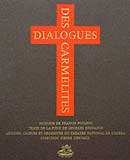 Within a week, he completed Litanies to the Black Virgin, the first of a series of austere a cappella religious works. This new profundity and gravity ultimately led to his 1957 opera Dialogues of the Carmelites, which traced the transformation of a young nun from an eager novice to a martyr of the French revolution. Musically, it harks back to the lyric declamatory romanticism of Verdi, but tightens the narrative by avoiding arias and other distractions and relying on atmospheric orchestral interludes to paint the shifting moods. The conclusion is one of the most chilling in all of opera as a chorus of nuns resolutely singing a Latin hymn is gradually reduced to silence by ghastly blows of a guillotine, finally leaving the novice all alone to face the final decision of her life. Within a week, he completed Litanies to the Black Virgin, the first of a series of austere a cappella religious works. This new profundity and gravity ultimately led to his 1957 opera Dialogues of the Carmelites, which traced the transformation of a young nun from an eager novice to a martyr of the French revolution. Musically, it harks back to the lyric declamatory romanticism of Verdi, but tightens the narrative by avoiding arias and other distractions and relying on atmospheric orchestral interludes to paint the shifting moods. The conclusion is one of the most chilling in all of opera as a chorus of nuns resolutely singing a Latin hymn is gradually reduced to silence by ghastly blows of a guillotine, finally leaving the novice all alone to face the final decision of her life.
To this bewildering array of styles can be added a few constants that unify all of Poulenc's music – a fine sensitivity to the human voice (developed in an extraordinary series of song settings of surrealist poets), an amazingly fertile melodic invention, an essentially 19th century sound spiced by sudden harmonic shifts, an efficiency that constantly moves forward and avoids repetition, a lightness of touch, a sense of innocent wonder, a luminous clarity and above all sincere humility.
All of this infuses his Gloria, which is remarkable not only for its wide range of emotions, from teasing impudence to pensive reverence, but for the sheer amount of material it packs into its 25 minutes.  The very beginning announces at once its grand scope and intensely human focus – it reaches back to the past with a majestic and exciting fanfare which immediately recedes into a warmer, richly harmonized register to dispel any suggestion of aloofness or royalty; probing chords add a sense of penetrating quest, quickly dispelled as the chorus builds a rising affirmative figure over swirling strings. The very beginning announces at once its grand scope and intensely human focus – it reaches back to the past with a majestic and exciting fanfare which immediately recedes into a warmer, richly harmonized register to dispel any suggestion of aloofness or royalty; probing chords add a sense of penetrating quest, quickly dispelled as the chorus builds a rising affirmative figure over swirling strings.
If you fear classical religious music as long, grim and boring, don't worry – Poulenc charges constantly ahead through a dense but joyous kaleidoscopic journey. The fourth movement, lasting barely a minute, is woven from no fewer than a half-dozen evanescent melodies. Like a well-structured pop song, it's over so fast you just want to hear it again. There's nothing intense or prolonged here – in deference to modern attention spans, Poulenc effortlessly careens among moods of elation, wonder and contentment.
The last minute encapsulates both Poulenc's genius for seemingly effortless efficiency and the depth of his surface simplicity. It's a disarmingly plain yet multi-layered and overwhelmingly effective exploration of the multiple implications of “Amen.” A lush meditative mood is broken by a brisk Amen of the full chorus, followed by a sharp orchestral chord, thus reinforcing the traditional use of the word as marking a definitive end to prayer. 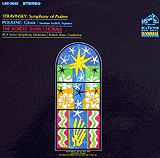 But then a solo soprano glides through a loud, sinuous Amen, wandering desperately until, at the end of her breath, she settles on a final note of doubt, ancient in its chant-like sound but modern in its brash, questioning spirit. The chorus then intones a soft, lushly-harmonized Amen of reassuring peace and eternal calm. Barely audible, the soprano suggests one more Amen in a challenging bittersweet suspension of eternal unresolved mystery. But then a solo soprano glides through a loud, sinuous Amen, wandering desperately until, at the end of her breath, she settles on a final note of doubt, ancient in its chant-like sound but modern in its brash, questioning spirit. The chorus then intones a soft, lushly-harmonized Amen of reassuring peace and eternal calm. Barely audible, the soprano suggests one more Amen in a challenging bittersweet suspension of eternal unresolved mystery.
On that shimmering ambiguity the work ends. It's not only one of the most awesome moments in all of music, but brilliantly complex in all its levels of meaning. Although I've tried, words can't possibly describe the wonder of such a radiant set of events nor, for that matter, of the entire piece. You really just have to hear it.
The first recording of Gloria (now on EMI CD 47723) 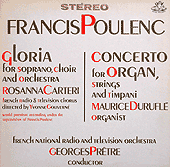 was made by the French National Radio-Television Orchestra and Chorus conducted by Georges Pretre. Taped the day after the February 1961 European premiere and supervised by Poulenc, it's entitled to instant respect as presumably realizing the composer's intentions. Yet, while soprano Rosanna Carteri (for whom the solo part was written) sings ravishingly and while the end is sublime, the rest is weighty and a bit tired, in surprising contrast to Poulenc's own headstrong and vital piano records (collected on Pearl CD 9311). (The CD also includes outstanding accounts of Poulenc's exuberant Concerto For Organ, Strings and Timpani that sounds like a baroque fantasia on adrenalin and the reverential a cappella Four Motets for a Time of Penitance.) The next version in 1965 by the Robert Shaw Chorale (last on RCA LP LSC-2822, nicely contrasted with Stravinsky's earnest and severe Symphony of Psalms) was more spirited and precise but hasn't made it onto CD. was made by the French National Radio-Television Orchestra and Chorus conducted by Georges Pretre. Taped the day after the February 1961 European premiere and supervised by Poulenc, it's entitled to instant respect as presumably realizing the composer's intentions. Yet, while soprano Rosanna Carteri (for whom the solo part was written) sings ravishingly and while the end is sublime, the rest is weighty and a bit tired, in surprising contrast to Poulenc's own headstrong and vital piano records (collected on Pearl CD 9311). (The CD also includes outstanding accounts of Poulenc's exuberant Concerto For Organ, Strings and Timpani that sounds like a baroque fantasia on adrenalin and the reverential a cappella Four Motets for a Time of Penitance.) The next version in 1965 by the Robert Shaw Chorale (last on RCA LP LSC-2822, nicely contrasted with Stravinsky's earnest and severe Symphony of Psalms) was more spirited and precise but hasn't made it onto CD.
Fortunately, of the dozen recordings since then the top recommendation  can go to a mid-priced release – a magnificent 1990 performance on Virgin 61843 by the Westminster Singers, City of London Sinfonia and soprano Catherine Dubosc conducted by Richard Hickox that's bright, airy, delicate (except for a slightly perfunctory end) and luminously recorded (although the deep bass is a bit unruly). (Its CD companions are Poulenc's 1938 Stabat Mater, a surprisingly sweet and upbeat setting of the prayer of grief, and his solemn 1936 Litanies to the Black Virgin, the work that had launched Poulenc's rediscovery of religion.) Another mid-priced contender, Leonard Bernstein's 1976 release with the New York Philharmonic, Westminster Choir and Judith Blegen (on Sony SMK 47559), is expressive and sharp, can go to a mid-priced release – a magnificent 1990 performance on Virgin 61843 by the Westminster Singers, City of London Sinfonia and soprano Catherine Dubosc conducted by Richard Hickox that's bright, airy, delicate (except for a slightly perfunctory end) and luminously recorded (although the deep bass is a bit unruly). (Its CD companions are Poulenc's 1938 Stabat Mater, a surprisingly sweet and upbeat setting of the prayer of grief, and his solemn 1936 Litanies to the Black Virgin, the work that had launched Poulenc's rediscovery of religion.) Another mid-priced contender, Leonard Bernstein's 1976 release with the New York Philharmonic, Westminster Choir and Judith Blegen (on Sony SMK 47559), is expressive and sharp, 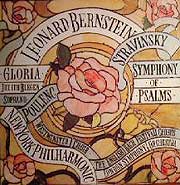 bounding with the conductor's superb sense of �lan and rhythm. (The Bernstein CD provides a striking contrast to the Gloria with a fine performance of Janacek's forceful Slavonic Mass.) Unfortunately, the only budget version (on Naxos), while propulsive and raising expectations of authenticity with its French forces, smothers a decent reading beneath weird balances and a blurry (albeit 1992 digital!) recording. bounding with the conductor's superb sense of �lan and rhythm. (The Bernstein CD provides a striking contrast to the Gloria with a fine performance of Janacek's forceful Slavonic Mass.) Unfortunately, the only budget version (on Naxos), while propulsive and raising expectations of authenticity with its French forces, smothers a decent reading beneath weird balances and a blurry (albeit 1992 digital!) recording.
One final matter – do you have to be a devout Catholic, or even Christian at all, to identify with Gloria and respond to it? No! After all, you don't have to want to be a paperback writer, catch a wave or paint it black to relate to rock nor, for that matter, dream of a white Christmas to enjoy pop. Like all great religious music, Gloria delves far beneath the details of its text to ask the eternal questions and explore the universal truths that lie at the base of all human understanding. Although its specific prayer may not be personally meaningful, the music it inspired will move anyone with even a spark of religious feeling. And even if you're not religious at all, you still have to respect the power of faith that stirred Poulenc and so many others before him to create such magnificently heartfelt expressions of human feeling.
Great music empowers each of us to transcend our troubled times and to soar at the very peak of human endeavor.

Copyright 2001 by Peter Gutmann

|
